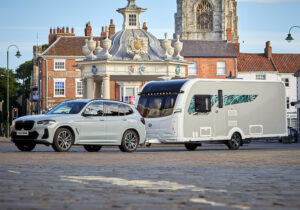Dan Cartwright has over 12 years of experience in the caravan and motorhome industry. He is a judge for a number of prestigious leisure vehicle awards and regularly heads off in his motorhome with his family. Every week, Dan shares his insights with the community. Here’s what he has to say this week.
Every year, as the evenings grow darker and the temperature cools down, there’s an influx of people looking to sell their leisure vehicles, rather than keep them over the off-season. However, for some, this poses a perfect opportunity to pick up a bargain.
This week in the Cartwright Chronicle, I’m going to be talking about exactly that and showing you some of the best deals I’ve spotted on the market right now. These listings represent fantastic entry points for those looking to pick up their first leisure vehicle, but also great value for more seasoned readers hoping to add something new to their collection.
So, without further ado, let’s go bargain-hunting!
Camping: Jamet trailer tent, £250
At this price, it’ll pay for itself in just two or three nights of camping. Jamet trailer tents are an absolute joy with huge amounts of space, giving you that authentic camping experience without compromising on room to move around.
The best thing of all is that a trailer tent leaves the back of your car available as a space for all of your camping paraphernalia, from bikes and skateboards to clothes, coolers and anything else you might need.
This Jamet tent also comes with a detachable kitchen area, which is incredibly handy and, again, saves precious boot space. Between us, I’m actually trying to convince my wife on one of these at the moment.
Campervans
Next, let’s take a look at a couple of campervan options. Before that, a word to the wise – I’d personally steer well clear of self-converted models. There are lots of them around and, although some are incredible, many are very risky unless you know exactly what you’re looking for. For the most part, it’s safer to just go with either a professionally converted campervan, or a production model.
VW T28, less than £5,000
Everyone loves these, right? This VW T28 has a pop top, it’s great for the family and comes with additional sleeping areas. It looks professionally converted, although it doesn’t say who did the work.
Either way, this certainly isn’t a DIY job. With everything you’d expect from a great campervan, including electric hookup and a side dinette, this listing looks fantastic, with plenty of pictures and a detailed description.
Autosleeper Duetto, £6,700
This one is a high-top van conversion, so you’ll be getting a proper seating area, separate from the driving and travel seats, as well as an inside toilet/bathroom.
Being an Autosleeper, you can expect that classic, practical layout, with great build quality to boot. You’ll have a full three or four-burner hob, a separate oven and grill, a large fridge and I think it may even have an additional roof sleeping compartment.
Motorhome: Autotrail Scout, £5,600
This is a beauty! The Autotrail Scout in question is as high spec as it could have possibly been in 2007, with only 57,000 miles on the clock and an asking price of £5,600.
This motorhome looks like it’s been lived in and loved, with a great family layout including the bed above the cabin. There’s optional leather habitation seating inside and, a little favourite of mine, this is the model built on the Mercedes chassis and engine configuration. So, at 57,000 miles, it’s barely got going. What a bargain!
Caravan: Bailey Pageant, £4,000
You can, of course, pick up caravans for much less than this Bailey Pageant. However, I wanted to highlight it because it boasts my favourite layout – the double lounge (front and back), with all of the service aspects situated in the middle.
It’s a fairly large caravan, with plenty of space for everyone to sit comfortably and those two beds that make up either side are very large, perfect if you’re particularly long like myself.
Considering the cost of a new caravan of this size and structure, this listing is a very good deal and a fantastic entry point to caravanning. Plus, unlike vehicles that have an engine, there’s much less that could go wrong!
Towcar: Porsche Cayenne, less than £5,000
If you’ve picked up a trailer tent or a caravan, you’re going to need a towcar as well and this is one of my all-time favourites. This 2011 Porsche Cayenne is a car I’ve tested many, many times throughout my years as a Towcar of the Year judge for the Caravan and Motorhome Club.
Having driven quite a few different Cayennes, I can safely say they make incredible towcars. The combination of power, torque and stability is just beautiful. The Porsche always wins its category, if not the full award. In fact, most years, it’s hard to find another winner – it’s that good!
Buyer beware
Please note that I haven’t checked out any of these listings in person. I simply wanted to give some examples of what’s out there right now.
So, don’t go and buy one, then blame me if it breaks! But on a serious note, do be very careful. I’ve used Facebook Marketplace to find these, but check out other sources, from eBay to your local newspaper.
The proliferation of second-hand selling websites means that scams are now more common. I’ve been there myself, but if something looks too good to be true, seriously consider the fact that it might be.
Here’s one potential scam that caught my attention whilst compiling this article. Let us know if you agree!
Photo credit: Kampus Production / Pexels




